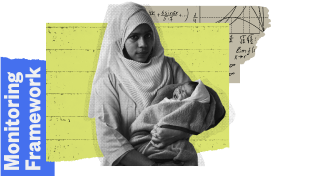The Gambia
Download full country profile
 2,739,090
Total Population
2,739,090
Total Population
A dispute exists between the Governments of Argentina and the United Kingdom of Great Britain and Northern Ireland concerning sovereignty over the Falkland Islands (Malvinas).
The boundaries and names shown and the designations used on this map do not imply official endorsement or acceptance by the United Nations.
The Gambia’s Population dynamics Data


Total Fertility Rate (births per woman)
Adolescent (15-19 years) Birth Rate (births per 1,000 girls)
Maternal Mortality Ratio (Per 100,000 live births)
The Gambia’s national commitment
At the Nairobi Summit, the Republic of the Gambia committed to achieving zero unmet need for family planning, including committing to creating and funding a budget line for family planning commodities and services in the national budget by 2020.
In the Gambia, unmet need for family planning is relatively the same in urban and rural areas but is highest among women with no education and women from the poorest households.
Demand for family planning satisfied by modern methods is highest among women with no education and women in the wealthiest households.
The Gambia’s maternal mortality ratio has been declining from 2000 to 2017,
the most recent year for which data is available, and the year in which it was estimated to be 579 deaths per 100,000 live births – about half that of the country with the highest maternal mortality ratio in the region.
The Gambia’s national commitment
The Gambia has committed to accelerating efforts to realize zero preventable maternal death. It has committed to revitalizing the primary health care system, increasing the proportion of births attended by skilled attendants, and ensuring the provision of basic lifesaving equipment, supply services, and medicines to all health facilities for maternal and new-born services by 2025.
The percentage of deliveries among married women 15-49 years assisted by a skilled attendant in the Gambia is 83.8% which is near the highest in the region.
This percentage increases slightly in urban areas, with education, and as household wealth increases.
The Gambia’s adolescent birth rate has declined from 1990 to 2020 to around 60 births per 1,000 girls, falling midway between other countries in the region.
The adolescent birth rate is two times higher in rural areas than in urban areas,
is 30 times higher among those with no education compared with those who have higher education, and is four times higher among those living in the poorest households compared with those in the wealthiest households.
In the Gambia, 24% of women aged 20-24 years were married before age 18, with 6% of women married before age 15.
Marriage before age 18 is highest among women living in rural areas, those women with no education and only primary education, and those women living in the poorest households.
The Gambia’s literacy rate among men is higher than that for women regardless of age group, however among those between 35-49 years, the literacy rate for men is two times higher than the rate for women.
Since the Nairobi Summit, strategic partnerships were secured through the Peacebuilding Fund (PBF) supported projects on youth and democratic processes, human security, and cooperation support to youth health enhancement and empowerment.















































